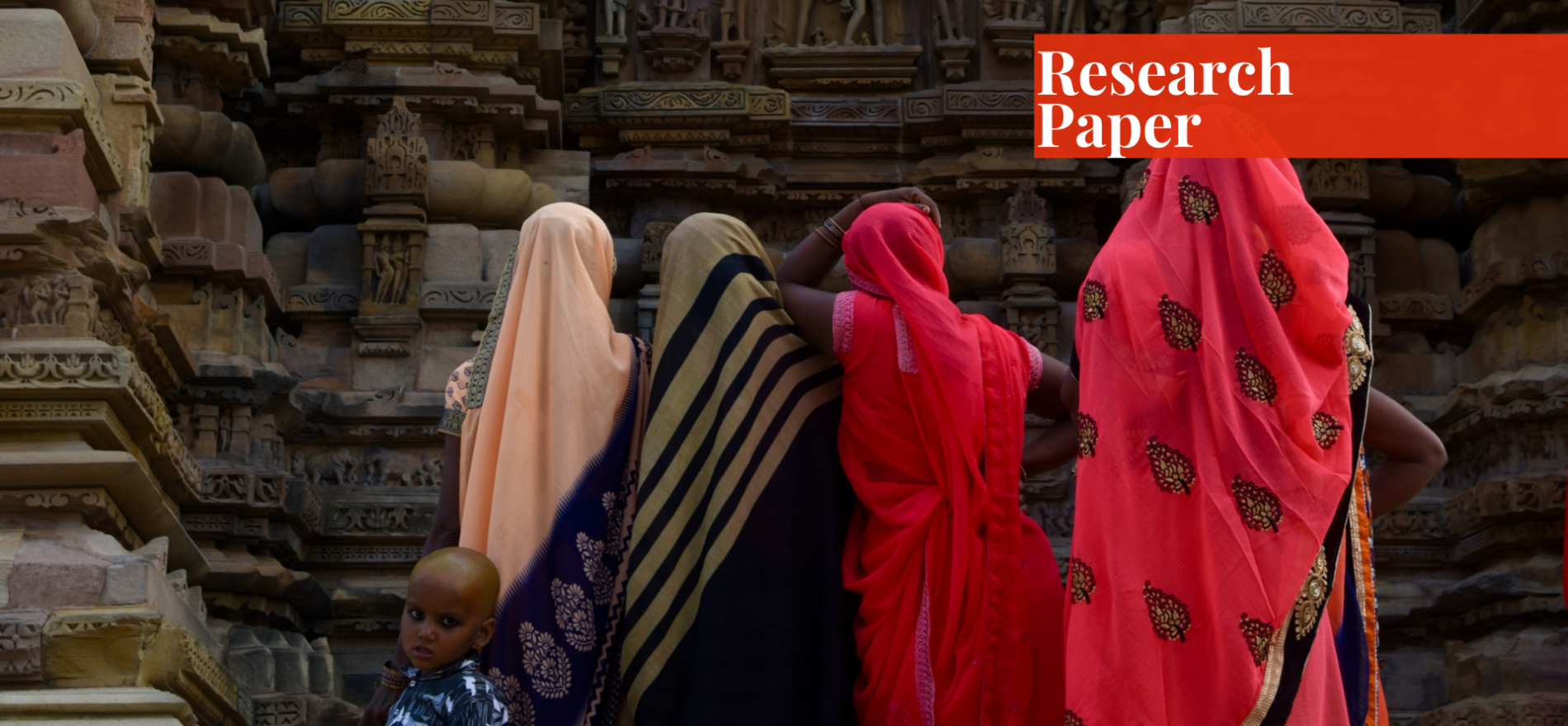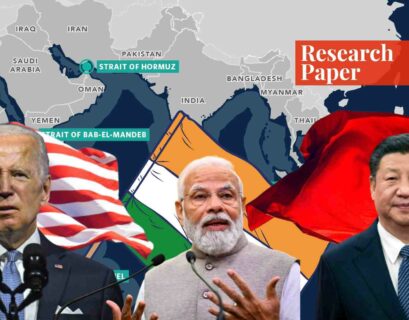Lyba Mobeen is currently pursuing her degree of BS-International Relations from Islamic University Islamabad.
Introduction
The concept of dowry, in general, is the transfer of parental property to the bride at the time of her wedding. However, today, instead of providing protection to the brides it subjects them to dowry harassment and deaths. Many forums and analysts have broadened and specified this concept of dowry as per their intellect. Nina Callaway (2020) asserts that “dowry is the giving of monetary or household gifts from the bride’s parents to her so that she feels safe and protected in her new home”.
Jack Goody (1976) also states that “the transfer of property, gifts; ranging from furniture to kitchenware to electronics; or money from bride’s side to groom and his family”. However, the Indian Dowry Prohibition Act 1961, clearly defines dowry, as “any valuable asset transferred from either of the sides, in response to the demands made by the other party”.
The voluntary grant of gifts from both sides is acceptable and does not count as dowry but, the gifts, money, properties given to bear the pressure from the other side either directly or indirectly, are termed as dowry and are constitutionally illegal. With dowry today, there are a few other phenomena associated—dowry harassment and dowry death.
As per the UN charter of DAW (Division for the Advancement of Women) definition, “dowry harassment is the violence an individual (specifically women) faces in relation to dowry demands by the other party either before or after the marriage” and “dowry death is the intentional murder or the commitment of suicide (navigated by her in-laws) by the woman who faces dowry harassment.”
Historical Background
The concept of dowry in the world is as archaic as the institution of marriage itself, though not necessarily in its current form, but it did exist.
Ancient Time Period
- The Babylonian Empire
The oldest written evidence of the dowry concept is present in the “Code of Hammurabi” (legal text) in the Babylonian Empire, which described dowry as an already existent culture and laid down the rules regarding the proper usage of dowry. Dowry, at that time, was the financial security, provided to the bride by her family, as the woman had no share in inheritance.
According to Herodotus, a Greek historian, in Babylon—the capital city of Babylonia—bride price and dowry auctions were conducted before marriage. If the brides at the auction were beautiful, less dowry would have to be paid by the bride’s family and they would secure more bride price. In the case of less beautiful brides, more dowry and less bride price would be given (McNeal, 1988). The husband had no legal right over his wife’s dowry, and it would be inheritable only by her own children.
- The Greek Empire
In ancient Greece, it was customary to give bride price only. But, in the classical Greek period, dowry’s notion emerged, as they also did not give women the right to inherit. Dowry was initiated with the aim of providing protection to the bride against any harsh or ill-treatment from her husband or in-laws (Wilson, 2002).
- The Roman Empire (753 BC – 476 AD)
The Romans practiced dowry culture to assist the groom in sustaining post-marital expenditure. It was also a gesture of a woman’s contribution to the newly married life. The dowry at that time was any form of property given or promised at the time of marriage. The dowry was to be paid in installments or in single pay-out, depending upon the social status of the bride’s family (Siculus, n.d.).
Two types of dowry were known at that time:
- Dos Profectita – provided by bride’s father.
- Dos Adventita – provided by any other family member.
- Persian Empire (559 BC–331 BC)
Ancient Persians had no concept of dowry until they fell under the Greek and Roman influence. Women had a share in property and inheritance before that.
- Byzantine Empire
Dowry culture prevailed there. The bride’s dowry along with the pre-marital donation from the groom (bride price) collectively called for the property of the new couple.
- Asia
There is evidential support in the Code of Manu which verifies the presence of dowry and bride price culture being practiced in the 3rd century BC in the Indian subcontinent (Jack & Stanley, 1973). Dowry, at that time, was associated only with the prerogative class of Brahmins and Kshatriyas, and a bride price was given to the lower class and caste families who could not afford a dowry.
In Chinese culture, the dowry was under the direct control of the wife. Confucius’s teachings taught the right use of dowry, but the tradition of bride price was more common and practiced. Dowry symbolized the prayers and affection of the bride’s family for the couple and it held the importance of inheritance for the lady.
Middle Ages (5th–15th Century)
- Asia
Muslims came to power in India in the 8th century and abolished the notion of dowry. The Brahmins, however, continued to practice this concept in their areas (Nair, 1978).
- Europe
The dowry norm was persistent in the Middle Ages in Europe. The nuns brought dowry with them before joining covenants, as they were considered the brides of Christ. Even the royal bride got land property as her dowry as well as an inheritance at her wedding, e.g. when Charles II of England got married to Catherine of Braganza (Portugal), she was given 2 cities in India and Morocco as her dowry in 1661 (Holmes, 2005).
Modern Era (15th–19th Century)
- Asia
Urbanization escalated with the British colonial rule in India so, social strata emerged and with that, the concept of dowry became widespread (Nair, 1978).
With the Cultural Revolution in China in 1966, came a decline in the dowry and bride price custom, by labeling it as an unethical, materialistic, and capitalistic action. But, in late modern times, with the introduction of Chinese reforms, both the practices along with many other ancient customs, re-emerged and have been persisting since the 1980s.
- Europe
With Christianity came the culture of dowry. In the Victorian era, dowry pertained as the earliest form of inheritance. The bride received the right to inherit the dowry depending upon the parents’ choice. The larger the dowry of the bride, the better the match. Providing dowry for poor families’ daughters was a charitable act. It was even used as a penalty and punishment against rapists to compel them to provide the bride’s dowry whom they had raped. The most common form of dowry was the land property, which was under the control of the groom and his family (Wallace & MacColl, 1989).
- South America
Initially, dowry and bride price traditions were present, but after colonization by the Spanish and the Portuguese, the norms reformed and were under the influence of Roman Law.
Post-Modern Era (19th Century Onwards)
Dowry even today, is considered a ritual and binding commitment, whereas, in some parts, it has become a means of business and trade among families to buy and sell their sons/daughters. The practice has decreased in developed countries or has taken another shape. In the United States, dowry has been revamped into “hope chests” which includes material things as well as the training and brought up of the girl for being a good homemaker
However, in developing regions and states like India, Pakistan, China, Asia, Africa, Balkans, and even some modern societies of England and Australia, the tradition continues and has instigated many social dilemmas as well—including domestic violence, abuse (physical and verbal), dowry harassment and even deaths.
Case Studies of Dowry Deaths and Harassment in India
Case I: The State of Bihar vs Mitrunje Kumar
Charu Lata, a resident of Patna, Bihar was married to Mirityunje Kumar in 2012. At the time of marriage, 20 Lacs were spent by the bride’s family in the wake of dowry but, soon after the wedding, the in-laws demanded another 15 Lacs, for which they harassed, tortured, and beat her on a daily basis. In the meantime, Charu Lata got a job in a bank as a provisional officer and her in-laws started feeding off her job and salary.
Despite having a degree in hotel management from Australia, Mirityunje was unemployed, and he felt jealous of his wife’s success which kept on stockpiling within him, and that envy in him, burst like a volcano on 24th July when he blatantly murdered his wife (Choudhury, 2016a).On that day, Charu Lata became one of the thousands of dowry deaths cases in India. To ensure she does not speak up to anybody at work, her husband kept an eagle’s eye on her everywhere she went.
Even though Charu Lata’s entire salary used to be deposited in her father-in-law’s account and an additional 2 Lacs were also provided by the bride’s family but unfortunately, all of this was not enough to satisfy their greed. One day, Charu Lata had enough and refused to give any more money to them and that was when she called upon her death. Her husband tied her up with ropes and tortured her firstly, then killed her through strangulation in front of his family and nobody stopped him.
After killing Charu Lata, he tried to get rid of her body by cutting and disposing of her body parts which he could not do, therefore, having no other option, he burned her, and the family took her 30 months old son with them and ran away, locking the body in the house on 24 July 2016. The body was recovered a few days later and cases were filed against the culprits soon after.
Her autopsy report mentioned the presence of several deep injury marks on her body and those marks were made by a sharp knife and other apparatus. The husband was arrested three days later on 28th July and confessed his crime in front of the police and is now in jail completing his penalty (Choudhury, 2016b).
Case II: Sindhu Sharma vs Vasista Nooty
Just when one thought dowry harassment and deaths are a phenomenon of rural society, came forward a case of dowry harassment in the literate society of Hyderabad. Sindhu Sharma married Vasista Nooty—the son of a retired Hyderabad High Court judge, Nooty Ramamohana Rao—in August 2012, and since then, she has been abused, harassed, and tortured for more dowry.
Initially, the abuse was only verbal but with progression in time, the harassment grew severe and took the shape of physical assault from 2018. As per Sindhu’s statement, her father met each and every demand of the groom’s family before the wedding. Even though he could not afford some of the demands, he still managed to go through it for the sake of his daughter’s happy married life but soon after the marriage, they started demanding more.
On 20th April 2019, Sindhu narrates that when her husband and in-laws came home after watching a movie, Vasista woke her up from sleep and started beating her up for not being promoted and his mother-in-law instigated in him this feeling and pushed him to the limits where he blamed Sandhu for every blockade in his life (Sadam, 2019). When the torture raised the bars, the in-laws interrupted and started thrashing her instead of stopping their son and even the household servants joined and abused her in a group.
The assault grew so bad she had to be admitted to the hospital when she blacked out. Even after reaching the hospital, they had to make sure Sindhu did not speak up to anybody. Her in-laws told the doctors that Sindhu was mad and needed drugs to alleviate her condition. The doctors, however, conducted a complete treatment and found many wounds and bruises on her body.
After this, the doctors helped Sindhu contact her parents and she filed a complaint against her in-laws and husband for dowry harassment under sections 498A (torture by in-laws), 323 (consciously causing pain), and 406 (criminal violation of trust) of IPC and DPA (Dowry Prohibition Act) (Sunku, 2019).
Sindhu even released CCTV footage of the 20th April incident where her in-laws can be clearly seen as intentionally assaulting her in front of her children. Sindhu, despite facing extreme cruelty, is ready for any negotiations as she does not want her children to grow up without a father and does not seek to file a divorce but, justice (Sadam, 2019).
Case III: Kerala Police vs Chandulal
Thushara, a resident of Kollam district, Kerala, married Chandulal in 2013. In the name of dowry, her in-laws were given 20 sovereigns (coins) of gold. But soon after the wedding, they harassed her for more. Thushara’s husband took her phone, did not allow her to visit her parents, portrayed her as mentally unhealthy, didn’t allow her to go outside the house, and was not even given enough to eat.
The neighbors confirmed she used to be harassed physically and her mother-in-law was even engaged in witchcraft (“Kollam: Murder Charge,” 2019). Thushara bore all this for six consecutive years but in March 2019, their attitude became inhumane, and they started starving her. For three weeks, she was only given soaked rice to survive (Jayarajan, 2019).
On 21st March, Thushara died of pneumonia which was caused by chronic starvation later confirmed by her post-mortem report. At the time of her death, she weighed only 20 kgs and was nothing more than a “bag of skeleton” as witnessed by the people (Philip, 2019). A case of dowry death under section 304B (causing death by negligence) was filed by the Kerala police and the husband Chandulal and mother-in-law Geetha have been arrested, taken into remand, and are being trialed and her two children (aged three and one and a half years) have been sent to child protection home.
Case IV: Reshma Ganesh Puwa
Reshma Ganesh Puwa is another woman in rural India (Jamkhed) who was harassed and almost became a victim in another case of dowry deaths in India. Reshma’s in-laws specifically her mother-in-law used to torture her over daily life affairs, by not giving her food and not allowing her to play with her children, in order to compel her to bring more dowry but, her parents could not afford to do so.
Therefore, her mother-in-law wanted her son to marry another girl to bring more dowry and to get rid of her. One day, she threw gasoline on Reshma and set her on fire in front of her own children (Cawood, n.d.). She had been burnt 60-70% before she received medical assistance and she could not even wear clothes in the initial time period after being burned.
She did not file any case against her in-laws or husband and so, nobody has been punished. Nine months after being treated in CRHP’s (Comprehensive Rural Health Project) hospital with utmost care and attention, Reshma is gradually going towards life and is now able to wear clothes and move around.
Findings
Current Status of Dowry Culture in India
Dowry, like many other social phenomena, comes with its baggage of pros and cons. Though the custom is criticized openly, yet it persists as some people defend its prevalence arguing that:
- It helps the newly married couple to settle themselves economically and socially in their new chapters of life. The bride bringing household items including cutlery, furniture, crockery etc. relaxes the groom financially and helps the bride in getting familiar around the new household with her own accessories.
- Dowry helps promote inter-caste marriages (lower with higher or vice versa) and can counter the caste-system stigma as well as inter-religious and inter-state marriages which can be defended through large dowry.
- As per the favourers, dowry helps to elevate the status of bride in her new home, gets maximum importance and boosts her self-confidence as compared with those who do not bring dowry in any form.
Despite these benefits, dowry today has become a social stigma and has taken the shape of a business deal that takes place before the marriage between two families, and even causes many evils to stem post-marriage as well.
- Dowry becomes a burdening liability over the bride’s parents. In India, where 95% of its population constitutes of poor and low-income strata, it becomes very difficult for the parents of the bride to satisfy all the demands of the groom’s side (Venkataramakrishnan, 2015). Resultingly, they have to borrow or loan a big amount to marry their daughter and spend a lifetime returning that loan.
- Another horrible effect of dowry custom is the abuse and killings involved. Women are tortured and assaulted by their husbands and in-laws on daily basis to bring in additional dowry. “The violence ranges from brutal beatings, emotional torture, withholding money, throwing them out of the house, keeping them away from their children, keeping mistresses openly,” or in extreme cases, “burning the wife alive,” Savra Subratikaan, a women rights activist told a reporter (McCarthy,2017). More than 7,000 brides are averagely murdered in India and the numbers of dowry deaths in India are, most of the time, under-reported (Cole, 2018).
- Dowry promotes early child marriages because the younger the bride, the lesser will be her dowry and so parents do not bother to spend on the girl’s education rather they marry her off. India lists top in the world where highest number of child marriages are conducted.
- Dowry culture treats women as a second-grade property that can be bought and sold as per the buyers’ convenience, instead of humanizing them as an individual. The worth of a woman is associated with her dowry, the greater the dowry, the more the significance of the bride. On the other hand, the lesser the dowry, the more the woman is subjected to torture and abuse.
- Extensive dowry keeps the parents of the bride under huge debts and to pay those debts with high interest rates, they sell off their assets and properties which could be the source of bread and butter for the family and are forced to live a life of low standards. This is the same reason why parents in the rural areas still kill their infant daughters, to get rid of the social stigmas associated with a daughter.
Dowry Deaths and Harassment in India
As per National Crime Records Bureau (NCRB) statistics in 2019,
- A woman in India becomes a victim of dowry harassment, every hour.
- A woman in India faces torture and abuse from her husband and in-laws, every four minutes.
- On an average of 15 years, 6-8 thousand women become victim of dowry deaths in India, every year.

These shocking revelations speak for themselves the severity of the issue of dowry harassment and deaths in India alone and these stats are merely based on the reported cases whereas, many folds of cases are still not reported for whatever reasons. Though dowry was for once, associated with illiteracy and rural areas only, but now, dowry deaths and harassment in India have penetrated the literate societies and urban centers as well, and are nothing short of a social evil for brides and their families.
Bride Protection in the Indian Constitution
The Indian constitution has provided every possible protection to brides and their families by incorporating legal avenues, laws, and bylaws, for instance:
- Section – 304(B) marks the death of a married woman due to bodily injury or abnormal conditions as “dowry death” and imprisons the perpetrators from 7 years to full-time life imprisonment.
- Section – 498(A) imprisons the husband or/and his family members for 3 years or fines them depending upon the situation if they are proved to be torturing the wife.
- The Dowry Prohibition Act, 1961 has declared the give and take of dowry as illegal and anybody found to be non-complying with the law shall be punished for minimum of 5 years or fined (not less than 15K), as per the circumstances.
- Section – 302 states whoever commits murder (especially of women) shall be imprisoned for life and fined too.
- Section – 306 punishes the abettor of a suicide (especially under dowry death) up to 10 years depending upon the case.
- The Evidence Act 1872, Section – 113(B), presumes the death of a married woman as “dowry death” if right before death she had been subjected to harassment or torture by her husband or in-laws and shall be penalized accordingly.

Why Dowry Still Persists
After analyzing the core problem and cases of dowry deaths and harassment in India, assessing the pros and cons it comes with, and inspecting such an interwoven network of protection laws and rise in digital and social media, one often finds oneself asking the question Why? Why is dowry not outdated yet? Why do the literate and illiterate have the same attitudes in matters of dowry? The reasons behind this dilemma may be multiple:
- Lack of Awareness
Even though one assumes people to be fully aware in this century of digitization and globalization but, the reality is still different. Many of the Indians are not yet aware of the Dowry Prohibition Act and of the fact that dowry is constitutionally illegal and that is the main reason why many of the dowry deaths and harassment cases in India go unnoticed and underreported.
- Social Acceptance
Another reason why dowry is not considered obscene, despite the tremendous amount of dowry deaths in India, is that people have collectively accepted it as a social tradition, obligation, or compulsion on behalf of both the families and that acceptance is to such an extent that even literacy and education could not foster the feelings of illegality amongst masses regarding dowry practices.
- Patriarchal Attitude
Indian social fabric, like all other Asian societies, is male-dominant. In matters varying from earning bread and butter for the family and daily life settlements to making momentous decisions regarding women’s life, the males clearly have an upper hand. This dominancy approach has egged on the dowry culture and made it obligatory to give the groom lush gifts in the name of dowry, as he is a male and needs to be treated exceptionally, even though he himself is not worth it.
- Socio-economic Structure
India, where 95% of the population belongs from either the low or poor-income class, dowry there, in the form of property or money, becomes a good source for an unemployed or less earning groom to settle himself.
Economic strata combined with social attitudes and ill-education strengthens the culture of give and take at weddings and has made it so powerful and intertwined in the societal structure that to get rid of this social menace will be one arduous task.
Recommendations
Eliminating dowry, and the deaths and harassment associated with it, is not just a one-step process. It would require a sequence of simultaneous and effective actions to be brought about, foremostly a change in the societal thinking and mindset, without which, no change is possible. Following are a few recommendations that can be taken into account in order to control this curse.
- Awareness
First of all, the general masses need to be conscious of the fact that giving and taking of dowry is, by law, a crime and it poses serious reverberations for the culprits. A nationwide campaign should be commenced covering all the urban and rural centers of the Republic of India, comprising of volunteers and public figures who shall educate the citizens regarding the ill effects of dowry practice.
- Marriage Fund
An argument widely given in the favour of dowry is the financial settlement it provides to the husband. In order to tackle it, the government should set up a sovereign fund called the “Marriage Fund” to monetarily assist the newly married couples in establishing some business or providing financial security.
- Promote Whistle Blowing
The government should encourage the citizens with incentives and prizes to blow the whistle whenever they witness any dowry exchange being practiced. That would not only put a stop to this ill-practice but will also motivate people to speak up against the wrong.
- Strict Implementation of the Law
The constitution provides the maximum protection it could through its legal passages but where the government lacks is the implementation of that law, and this is where it needs to work on. It should establish separate police centers for dealing with dowry deaths in India, and dowry harassment and torture, and ensure the perpetrators face a complete trial and reach their conclusion in every case so that, some examples are set. Emergency helplines should be created and made accessible to women in every village or city where they could file complaints against the responsible without having to open their identity.
Conclusion
Dowry culture in Indian society, which was initiated with the purpose of providing protection and safety to the brides against any harm, has now become the core reason for infliction of harassment, torture, and assault upon them. Dowry deaths in India have become a common occurrence.
Despite the legal covers, we, as a society and nation, have failed to provide security to our women and it is the need of the hour to revamp our attitudes, our mindset, and our treatment towards women and discard this obscenity of give and take from the society. They need to be viewed not as a showpiece that could be sold and bought as per the buyers’ convenience but as equal human beings and a complete individual like men.
References
- Callaway, N. (2020, September 17). What is a Wedding Dowry? The Spruce.
- Cawood, L. (n.d.) Community leaders: The story of Reshma (Julia Hospital Patient). CRHP Jamkhed Blog. https://jamkhed.wordpress.com/2014/05/20/burned-alive-the-story-of-reshma/
- Choudhury, S. (2016a). Bank PO found murdered in husband’s home. The Times of India. https://timesofindia.indiatimes.com/city/patna/bank-po-found-murdered-in-husbands-home/articleshow/53384388.cms
- Choudhury, S. (2016b). Husband confesses to killing bank PO, alleges illicit affair. The Times of India. https://timesofindia.indiatimes.com/city/patna/husband-confesses-to-killing-bank-po-alleges-illicit-affair/articleshow/53439845.cms
- Cole, D. (2018). https://www.npr.org/sections/goatsandsoda/2018/11/30/671872574/u-n-report-50-000-women-a-year-are-killed-by-intimate-partners-family-members
- Goody, J. (1976). Production and Reproduction: A Comparative Study of the Domestic Domain. Cambridge: Cambridge University Press.
- Goody, J., & Stanley, J. T. (1973). Bridewealth and Dowry. Cambridge: Cambridge University Press.
- Holmes, F. (2005). The Sickly Stuarts. https://www.thehistorypress.co.uk/publication/the-sickly-stuarts/9780750932929/
- Jayarajan, S. (2019). Starved by husband and in-laws, Kerala woman was only 20 kgs when she died. The News Minute.https://www.thenewsminute.com/article/starved-husband-and-laws-kerala-woman-was-only-20-kgs-when-she-died-99215
- Kollam: Murder charge slapped in dowry death case. (2019). Deccan Chronicles. https://www.deccanchronicle.com/nation/current-affairs/020419/kollam-murder-charge-slapped-in-dowry-death-case.html
- McCarthy, J. (2017, June 6). 9 Reasons Why Dowries Are Horrible for Women. Global Citizen. https://www.globalcitizen.org/en/content/8-reasons-dowries-are-bad-for-women/.
- McNeal, R. A. (1988). The Brides of Babylon: Herodotus 1.196. Historia: Zeitschrift Für Alte Geschichte, 37(1), 54–71. https://www.jstor.org/stable/4436038
- Nair P. T. (1978). Marriage and dowry in India. South Asia Books.
- Philip, S. (2019, March 31). Kerala woman starved to death over dowry; husband, mother held. Indian Express. https://indianexpress.com/article/india/kerala-woman-starved-to-death-over-dowry-husband-mother-held-5650982/.
- Sadam, R. (2019) ‘They Hit Me in Places I Cannot Reveal’: Daughter-in-Law of Former HC Judge Alleges Domestic Violence, Releases Video. News18. https://www.news18.com/news/india/they-hit-me-in-places-i-cannot-reveal-daughter-in-law-of-former-hc-judge-alleges-domestic-violence-releases-video-2317259.html
- Siculus, D. (n.d.) The Library of History Book XXXI. Loeb Classical Library Edition
- Sunku, D.P. (2019). Will stay with my husband: Sindhu Sharma. Deccan Chronicles. https://www.deccanchronicle.com/nation/current-affairs/220919/will-stay-with-my-husband-sindhu-sharma.html
- Venkataramakrishnan,R. (2015, July 10). Everyone in India thinks they are ‘middle class’ and almost no one actually is. Scroll.in. https://scroll.in/article/740011/everyone-in-india-thinks-they-are-middle-class-and-almost-no-one-actually-is.
- Wallace, C., & MacColl, G. (1989). To marry an English Lord or, how anglomania really got started. Workman Publishing Company.
- Wilson, N.G. (2002). Dowry. Encyclopaedia of Ancient Greece.
If you want to submit your articles and/or research papers, please check the Submissions page.
The views and opinions expressed in this article/paper are the author’s own and do not necessarily reflect the editorial position of Paradigm Shift.



















